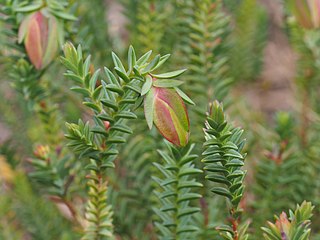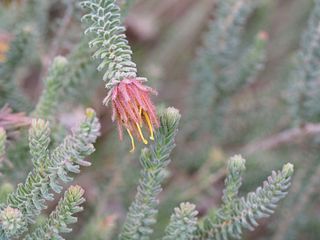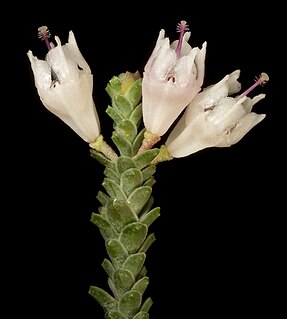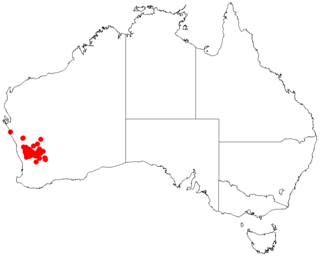
Darwinia, sometimes commonly known as mountain bells or simply bells, is a genus of about 70 species of evergreen shrubs in the family Myrtaceae, endemic to southeastern and southwestern Australia. The majority are native to southern Western Australia, but a few species occur in South Australia, New South Wales and Victoria. The genus was named in honour of Erasmus Darwin, grandfather of Charles Darwin by Edward Rudge in 1816. Most darwinias grow to a height of between 0.2 and 3 m, and many are prostrate shrubs. Most have small, simple leaves and the flowers are often grouped together, each flower with five red, white or greenish petals and ten stamens. In many species, the flowers are surrounded by large, colourful bracts, giving rise to their common names.

Banksia polycephala, commonly known as many-headed dryandra, is a species of bushy shrub that is endemic to Western Australia. It has linear, pinnatisect leaves with up to twenty-five triangular lobes on each side, small, creamy yellow flowers in heads of up to seventy and egg-shaped follicles.

Darwinia citriodora, commonly known as lemon-scented darwinia or lemon scented myrtle, is a plant in the myrtle family Myrtaceae and is endemic to the south-west of Western Australia. It is a shrub with oblong to lance-shaped leaves and red, yellow and orange flowers over an extended period. It is a hardy plant in well-drained soil, is often cultivated and used as a rootstock for less hardy species.

Darwinia leiostyla is an erect shrub in the family Myrtaceae and is endemic to the south-west of Western Australia. It typically grows to a height of 0.3–1.5 m and has linear leaves up to about 10 mm (0.39 in) long crowded along the branches. Pendent, bell-shaped, flower-like inflorescences appear from May to January. These are clusters of small flowers surrounded by larger pink, red or white, petal-like bracts.

Darwinia meeboldii, the Cranbrook bell, is a shrub which is endemic to the south-west of Western Australia. It has an erect and straggly habit, growing to between 0.5 and 3 metres high. The bracts around the flowers form a pendent "bell" which is usually white with red tips. A group of 8 small flowers are concealed inside. These are primarily produced between August and November.

Darwinia squarrosa, commonly known as the fringed mountain bell or pink mountain bell, is a shrub that is endemic to the south-west of Western Australia.

Darwinia collina, commonly known as the yellow mountain bell, is a plant in the myrtle family Myrtaceae. It grows as an erect shrub 0.3–1.2 metres (1–4 ft) high with crowded elliptical leaves and bright yellow flower-like inflorescences. It is endemic to a few small areas in the Stirling Range National Park, Western Australia and as a result is classified as an endangered species.

Darwinia oxylepis, commonly known as Gillham's bell, is a plant in the myrtle family Myrtaceae. It grows as a dense, upright shrub 1.0–1.5 m (3.3–4.9 ft) high, and produces large numbers of red inflorescences prominently displayed on the ends of the branchlets in spring. It is one of a group of Darwinias including D. leiostyla, D. macrostegia, D. meeboldii, D. collina and D. squarrosa collectively known as mountain bells. The species is found in only a few seasonally moist gullies near the lower slopes of the Stirling Range National Park and nearby Porongurup National Park and is therefore classified as endangered.

Darwinia virescens, commonly known as the Murchison darwinia, is a plant in the myrtle family Myrtaceae and which is endemic to a small area on the west coast of Western Australia near Geraldton.
Melaleuca polycephala is a shrub in the myrtle family, Myrtaceae, and is endemic to the south-west of Western Australia. It is a sparsely foliaged, twiggy shrub with deep purple flowers in spring.

Darwinia apiculata, commonly known as the scarp darwinia, is a plant in the myrtle family Myrtaceae and is endemic to a small area in Western Australia. It is a rounded, densely branched, small shrub with thin red branches and scattered small leaves. The flowers are arranged in small groups on the ends of the branches, their most obvious feature being long, red, pointed bracts surrounding each flower and a longer red style with scattered hairs near its tip.

Darwinia capitellata is a plant in the myrtle family Myrtaceae and is endemic to the south-west of Western Australia. It is a bushy, many-branched shrub, very similar to Darwinia diosmoides but differs in the arrangement of its flowers, its more branched habit, prominent oil glands on the younger stems and its thinner, paper-like bracteoles. It was first discovered as a separate species when specimens of it were found to have a larger chromosome number than specimens of D. diosmoides.

Darwinia carnea, commonly known as Mogumber bell or Narrogin bell is a plant in the myrtle family Myrtaceae and is endemic to the south-west of Western Australia. It is a small shrub with narrow, keeled leaves and flowers in groups of about eight, surrounded by yellowish-green to pinkish-red bracteoles. It occurs in small, isolated populations near the towns which contribute to its common names. It is the only "bell-flowered" Darwinia to not grow in the Stirling Range National Park.

Darwinia chapmaniana, commonly known as Chapman's bell or Eganu bell, is a plant in the myrtle family Myrtaceae, and is endemic to the south-west of Western Australia. It is a low, rounded, spreading shrub with greyish, hairy leaves and flowers in heads of about 14 small, tubular flowers. The heads are surrounded by long, reddish-yellow, hairy bracts.

Darwinia masonii, commonly known as Mason's darwinia is a plant in the myrtle family Myrtaceae and is endemic to Western Australia.

Darwinia oldfieldii, commonly known as Oldfield's darwinia, is a plant in the myrtle family Myrtaceae and is endemic to Western Australia.

Darwinia pauciflora is a plant in the myrtle family Myrtaceae and is endemic to Western Australia.

Darwinia purpurea, commonly known as the rose darwinia, is a plant in the myrtle family Myrtaceae and is endemic to Western Australia.
Darwinia terricola, commonly known as the Blackwood bell, is a plant in the myrtle family Myrtaceae and is endemic to a small area in the south-west of Western Australia. It is a small, low, sometimes prostrate shrub with small, linear leaves and small groups of flowers surrounded by reddish-green bracts and which usually lie on the ground.

Darwinia whicherensis, commonly known as the Abba bell, is a plant in the myrtle family Myrtaceae and is endemic to the south-west of Western Australia. It is a small shrub with linear leaves and bell-shaped, flower-like inflorescences containing more than twenty flowers surrounded by bracts, the largest of which are red with green edges.



















